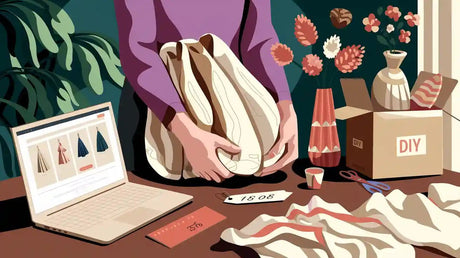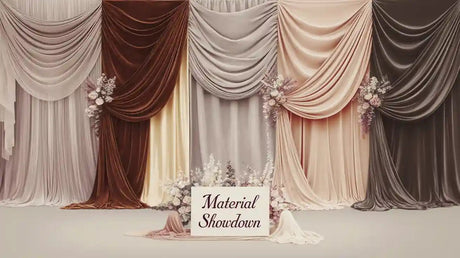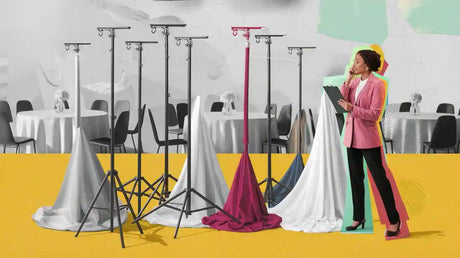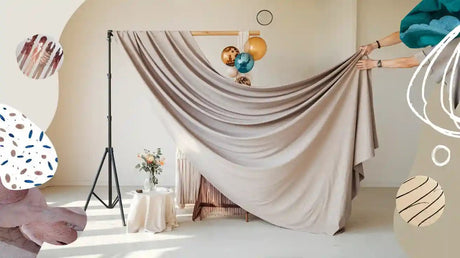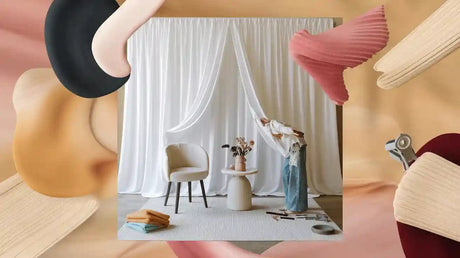
Eco-friendly cloth tablecloths are more than just pretty. They are a smart choice for your home and the Earth. Using reusable tablecloths helps cut down on waste and saves resources. Think about this:
If half of Americans used one paper napkin per meal, 164 billion napkins would be used every year.
Making 450 million paper napkins daily uses 31.5 million gallons of water. This amount could serve over 300,000 people each day.
Choosing cloth tablecloths made from organic cotton or hemp helps the planet. More people now prefer eco-friendly table linens, showing they care about the environment. Why not join them and let your table show your values?
Key Takeaways
Eco-friendly tablecloths cut down on waste and save resources.
Picking fabrics like organic cotton or hemp helps the planet.
Check for labels like GOTS and OEKO-TEX for safe products.
Natural fabrics last long, look nice, and are better for health.
Using eco-friendly tablecloths supports fair pay and helps workers.
What Makes Cloth Tablecloths Eco-Friendly?
Sustainable fabric options like linen, organic cotton, and hemp
Picking tablecloths made from linen, organic cotton, or hemp is eco-friendly. These fabrics come from nature and break down safely. Organic cotton is popular because it’s gentle on the planet. Hemp and linen last long and need fewer resources to make.
The eco-friendly fabric market is growing fast worldwide.
Organic fabrics were worth $19.15 billion in 2023. By 2032, they may reach $49.1 billion.
Organic cotton was the top choice in 2022, showing its demand.
Using these fabrics helps the environment and supports a sustainable industry.
Eco-conscious production processes and non-toxic dyes
Eco-friendly tablecloths are made with planet-friendly methods. Factories use renewable materials and skip harmful chemicals. Natural dyes, made from plants, are safer than synthetic ones. They lower pollution, save energy, and protect workers’ health.
Benefit |
Natural Dyes |
Synthetic Dyes |
|---|---|---|
Source |
From plants like flowers and leaves |
Made from petroleum |
Biodegradability |
Breaks down naturally |
Does not break down |
Toxicity |
Safe for people and nature |
Contains harmful chemicals |
Water Pollution |
Less water used, safe runoff |
Pollutes water with chemicals |
Energy Consumption |
Uses less energy |
Needs high energy to produce |
Impact on Health |
Safer for workers and families |
Can harm health |
Choosing tablecloths made this way helps the Earth and keeps your home healthier.
Certifications that ensure sustainability, such as GOTS and OEKO-TEX
Labels like GOTS and OEKO-TEX prove your tablecloths are eco-friendly. GOTS checks that fabrics are mostly organic and made responsibly. OEKO-TEX ensures products are safe and made without harmful chemicals.
Certification |
Criteria |
Requirements |
|---|---|---|
GOTS |
At least 70% organic fibers |
Must follow strict rules for eco-friendly and fair production, including organic fiber use, clean processing, and fair worker treatment. |
OEKO-TEX |
Tested for harmful substances |
Must meet safety and sustainability standards, checked by experts. |
Buying certified tablecloths shows you care about the planet and fair work practices.
Why Eco-Friendly Tablecloths Are a Sustainable Choice
Materials that grow back and break down naturally 🌱
Eco-friendly tablecloths use fabrics like linen, cotton, and bamboo. These materials grow fast and need fewer resources to make. Unlike plastic-based fabrics, they break down quickly and don’t harm the planet. When they’re old, they return to nature without leaving trash behind.
Linen comes from flax plants, which are easy to grow. Flax needs less water and energy than synthetic fabrics. Linen lasts a long time, so you won’t replace it often. This helps cut down on waste. Choosing linen tablecloths makes your meals stylish and helps the Earth stay clean.
Better for the planet than plastic-based fabrics 🌍
Plastic tablecloths, like polyester ones, come from oil. Making them pollutes the air and uses lots of energy. Natural fabrics like hemp and bamboo are better for the planet. They need fewer chemicals and less water to produce, making them a smarter choice.
Linen and bamboo are also very useful. You can use them daily or for special events. They look nice and help the environment at the same time. Picking these eco-friendly options lowers pollution and makes your table look great.
Supporting fair work and helping communities 🤝
Buying eco-friendly tablecloths helps workers get fair pay. Many brands focus on safe jobs and fair trade. For example, workers in Sri Lanka’s handloom industry earn good wages. These companies also use safe dyes and aim to waste nothing.
Fair trade helps workers earn steady money and reach global buyers. Some brands hire mostly women, giving them more independence. By choosing these tablecloths, you support fair jobs and a healthier economy.
Practical Benefits of Sustainable Tablecloths
Strong and long-lasting fabrics
Choosing linen or hemp tablecloths means they last a long time. These materials are tougher than cotton and get softer after washing. They stay strong even with regular use, unlike synthetic fabrics.
Property |
Description |
|---|---|
Durability |
Linen is stronger than cotton and lasts longer, even with regular washing. |
Low Maintenance |
Its natural texture gives a relaxed look, so ironing isn’t necessary. |
Quick Drying |
Dries faster than most fabrics, saving you time and energy. |
Linen tablecloths are also stain-resistant and easy to clean in a machine. They are great for daily use and help you save money over time while reducing waste.
Stylish designs for every home and event
Eco-friendly tablecloths come in many styles to match your taste. Whether you like bright colors, unique textures, or simple designs, there’s something for everyone. You can mix patterns to make your table look special.
Bold Colors and Prints: Great for parties or adding color to your dining area.
Textured Materials: Matches rustic, modern, or classic home styles.
Functional Features: Stain-resistant fabrics work well for daily meals or events.
These designs make sure your tablecloths fit any occasion, from casual dinners to fancy celebrations.
Safer home with natural fabrics
Natural tablecloths like linen help keep your home healthy. Linen doesn’t cause allergies and keeps dust mites away, which is good for sensitive people. It also breathes well, stopping mold and mildew from forming.
Stops bad smells, keeping your dining area fresh.
Free of harmful chemicals, making it safe for your family.
Using chemical-free fabrics creates a safer and cozier space for everyone at home.
Comparing Sustainable Tablecloths to Non-Eco-Friendly Alternatives
How synthetic materials like polyester harm the environment
Polyester tablecloths are bad for the planet. They are made from petroleum, which is not renewable. Making polyester releases harmful gases into the air. Washing them sheds tiny plastic pieces called microplastics. These microplastics pollute water and harm sea animals. They can even end up in the food we eat. Polyester also takes about 200 years to break down in landfills, causing long-term waste.
Natural fabrics like cotton or hemp are better choices. They don’t release microplastics and need less washing. This saves water and energy. Choosing natural materials helps protect nature and keeps your home eco-friendly.
Why sustainable tablecloths save money over time
Eco-friendly tablecloths may cost more at first. But they last longer, saving you money later. Linen and hemp are strong and don’t wear out quickly. You won’t need to replace them as often as cheaper options. This reduces waste and saves money. Using sustainable products also lowers landfill costs, helping the planet and society.
Buying eco-friendly tablecloths adds value to your home. They look great and are made to last. Over time, the savings and environmental benefits make them worth the price.
Beauty and usefulness of natural fabrics
Natural fabrics like linen and cotton are soft and breathable. They feel nice and come in many styles, from simple to modern. These fabrics are free of harmful chemicals, making them safer for your family.
Surveys show most people prefer cotton as a sustainable choice. Many are willing to pay more for better quality. This shows that eco-friendly options are becoming more popular.

Switching to sustainable tablecloths makes your table look better and helps the Earth.
Tips for Using Sustainable Tablecloths in Eco-Friendly Homes
Picking the best material for your tablecloth
Choosing the right tablecloth material is important for eco-friendly homes. Think about what you need. Linen is strong and grows without chemicals, making it a great green choice. Organic cotton is soft and breaks down naturally but uses more water to make. Wool lasts long and absorbs moisture but has a bigger carbon footprint because of sheep methane.
Here’s a simple guide to help you pick:
Factor |
What to Look For |
|---|---|
Make sure it fits your table for a neat look. |
|
Style or event |
Match the material to the mood you want to set. |
Fabric type |
Pick reusable, stain-resistant options for long-term use. |
Colors |
Choose shades that go well with your room décor. |
Cleaning |
Go for fabrics that are easy to wash and care for. |
The right material can make your home stylish and eco-friendly at the same time.
Decorating ideas for different events and spaces
Eco-friendly tablecloths can make your table stand out for any occasion. For a modern look, pair a plain linen tablecloth with simple dishes. This gives a clean and classy feel. Planning a nature-themed party? Use a cypress-inspired setup with dried flowers and recycled linen. It’s elegant and perfect for green events.
Here are some ideas to try:
Modern Look: Use plain, eco-friendly fabrics for a sleek style.
Nature Theme: Add dried flowers and earthy colors for a natural vibe.
Rustic Feel: Mix recycled fabrics with cozy, rustic decorations.
These tips help you create beautiful, eco-friendly spaces for any event.
Caring for sustainable tablecloths to make them last
Taking care of your tablecloths helps them last longer. Switch them out often to avoid wearing one out too quickly. Use placemats or chargers to protect the fabric from spills and heat. For daily use, a clear vinyl cover can keep your tablecloth safe from stains.
Other helpful tips:
Fix small rips or loose threads right away to avoid bigger damage.
Wash with gentle, eco-friendly soap to keep the fabric in good shape.
Let your tablecloths air-dry to save energy and keep their texture.
These steps will help your tablecloths last longer and keep your eco-friendly home looking great.
Eco-friendly cloth tablecloths are a great pick for your home. They are strong, stylish, and good for the planet. These tablecloths cut down on waste, last longer, and make your table look better. With features like easy cleaning and stain resistance, they are simple to use and eco-friendly.
Choosing sustainable tablecloths helps you live greener and shows your care for the Earth. Start using them now to enjoy a cleaner home and help the planet stay healthy.
Did you know? 75% of people think cloth tablecloths improve dining experiences.
FAQ
Why are eco-friendly tablecloths better for dining?
Eco-friendly tablecloths are strong, stylish, and good for the planet. They protect your table and cut down on waste. Made from natural materials, they make your meals healthier.
How should I clean natural fabric tablecloths?
Use gentle soap and cold water to wash them. Let them air-dry to keep their texture nice. Avoid strong chemicals to make them last longer.
Are eco-friendly tablecloths worth the cost?
Yes, they last much longer than plastic ones. Their strength means fewer replacements, saving you money and helping the Earth.
Can eco-friendly tablecloths fit different dining styles?
Yes! They come in many designs for casual meals or fancy events. You can find one to match any table setup.
Why pick eco-friendly tablecloths instead of synthetic ones?
Eco-friendly tablecloths break down naturally and don’t cause pollution. They are safer for your home and kinder to the planet.

